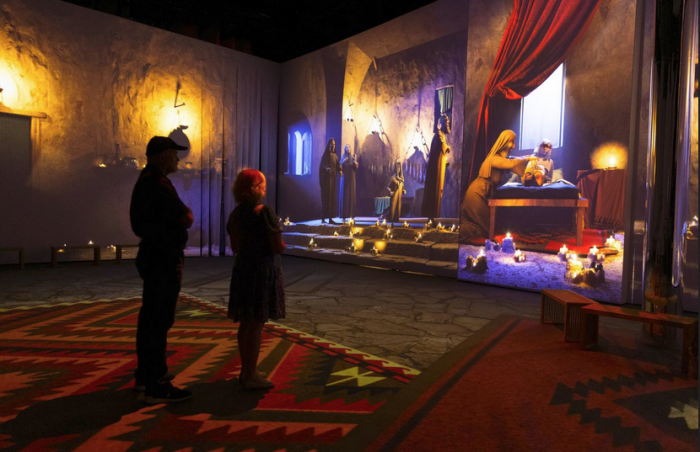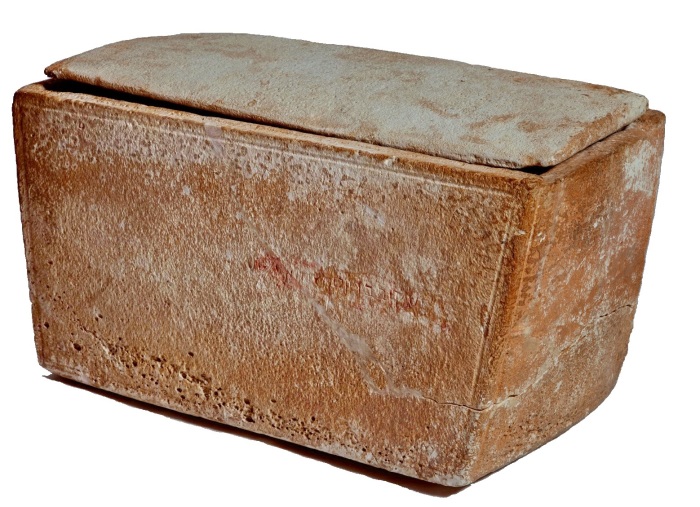Review: 3D immersive experience of 'The Nazarene' brings New Testament to life

DALLAS — If you’ve ever wanted to know what it's like to walk on water with Jesus — or watch the Apostle Peter try and fail to do the same — this could be your chance.
“The Nazarene,” an immersive, non-denominational retelling of the life of the Messiah based on the Gospels, isn’t merely a panoramic 3D movie — it’s a completely sensory experience that transports visitors back to first-century Israel.
Upon first walking into the experience, it’s easy, at least initially, to think you’re going to be viewing an art exhibit or something else static. Until the projection begins, that is, and you’re suddenly transported to the beginning of creation and introduced to the One who created it.
Spanning four separate galleries and 19 scenes with panoramic sound, custom composed music and breathtaking 3D sets, “Nazarene” is a multi-sensory, narrated journey that is both dramatic in its presentation and evangelistic in its content, repeatedly urging the viewer to consider God in His eternal power, the destructive plague of sin, and the condescension of Christ Jesus to destroy forever its hold on mankind.
Far from merely showing the events of the New Testament, “Nazarene” transports you right to where it happened: standing waist-deep in the waters of the Jordan River, for example, as Jesus comes to John the Baptist to “fulfill all righteousness” in his own baptism was one of the more stirring moments of the entire experience.
In fact, water plays a pivotal role in several of the best moments of “Nazarene,” including when Peter, James and John are fishing on the Sea of Galilee when Jesus commands them to lower their nets, resulting in an abundance that nearly causes the boats to sink.
Or when the disciples see Jesus walking on water and Peter asks Jesus to command him to step out onto the water, where he becomes afraid and begins to sink. The audience plunges along with Peter into the dark waters below, leading to a Michelangelo-inspired moment of Jesus’ hand reaching straight down into the deep and firmly grasping Peter’s hand, saving him from certain death.
These familiar scenes take on an immediacy and even a danger that a cursory reading of the Scriptures can often lack, pointing to the humanity of the Son of Man and His disciples. The pitter-patter of rain, the splashing into the deep, lightning and thunder — all are brought to life in a visceral presentation of the Scriptures themselves.
Once we arrive at Jesus’ triumphal entry into Jerusalem, the clamoring of the mob, both in their worship and their calls for crucifixion, takes on a more ominous tone. Even in animation, the scene of Jesus’ trial and Pontius Pilate, in particular, has a hyper-realism to it — including the use of 3D banners as Roman flags hanging over the audience — which leads into the darkest moments of the crucifixion of Christ and His triumphant cry of “It is finished!”
But it’s the resurrection of Christ that had probably the most striking imagery, as the risen Christ stands robed in white against a dark backdrop, beckoning the audience to come follow Him even as He promises to return.
It’s a Gospel moment that saturates the entire presentation from start to finish.
Notably, all the dialogue is spoken in both Aramaic and English, an artistic decision that executive producer Robert Bagdassarov of Alpine Artists said was highly deliberate.
“Historically, narratives have evolved to align with the cultural and linguistic zeitgeist,” Bagdassarov told CP. “The New Testament, for example, was crafted in Koine [Greek], the common dialect of its era, rather than the more esoteric classical Greek. This choice ensured the teachings remained accessible and resonant.”
“Our aspiration is to foster a deeper connection and reignite faith in the Crucified and Risen Savior in a way that's both relevant and impactful.”
Along with the immersive experience, “Nazarene” also features The Golan Collection, a collection of ancient artifacts from the land and time of Jesus, all of which organizers say were discovered within the Holy Land where Jesus, His family, His disciples and His followers lived, traversed and taught.

Curated by Oded Golan, a lifelong Israeli antiquities collector, the artifact collection ranges from the mundane, such as coins, kitchen utensils and fishing gear, to the same kind of nails believed to be used in crucifixions, such as Jesus, and various ossuaries, or bone boxes, from the time of Jesus.
The centerpiece of the collection is the James Ossuary, a first-century limestone bone box with intact etchings that read “James, Son of Joseph, Brother of Jesus.” The ossuary has been authenticated by archeologists and scientists as being that of James, the brother of Jesus, who was also the first bishop of Jerusalem, according to Golan.
While families are welcome, organizers say parental guidance is strongly recommended as some of the scenes in “Nazarene," such as the crucifixion of Christ, could be upsetting to younger children.
“The Nazarene” is set to run through Jan. 7, 2024.
Ian M. Giatti is a reporter for The Christian Post and the author of BACKWARDS DAD: a children's book for grownups. He can be reached at: ian.giatti@christianpost.com.




























